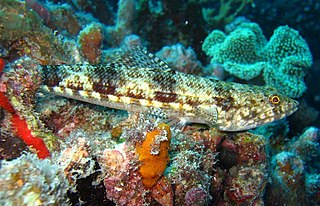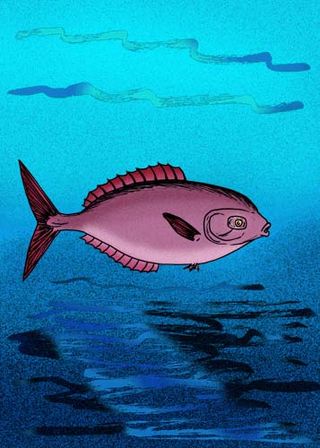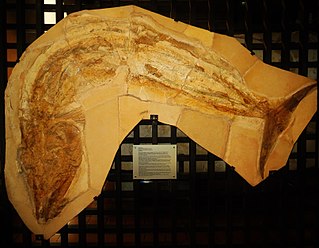
Aulopiformes is a diverse order of marine ray-finned fish consisting of some 15 extant and several prehistoric families with about 45 genera and over 230 species. The common names grinners, lizardfishes and allies, or aulopiforms are sometimes used for this group. The scientific name means "Aulopus-shaped", from Aulopus + the standard fish order suffix "-formes". It ultimately derives from Ancient Greek aulós + Latin forma, the former in reference to the elongated shape of many aulopiforms.

The Myctophiformes are an order of ray-finned fishes consisting of two families of deep-sea marine fish, most notably the highly abundant lanternfishes (Myctophidae). The blackchins (Neoscopelidae) contain six species in three genera, while the bulk of the family belongs to the Myctophidae, with over 30 genera and some 252 species.

Berycopsis is an extinct genus of marine ray-finned fish from the Late Cretaceous period. Fossils are known from England, Germany, and Lebanon. A potential specimen is known from the Czech Republic.
Congorhynchus is an enigmatic, likely polyphyletic genus of prehistoric marine ray-finned fish that was described by E. Darteville and E. Casier in 1949.

Cimolichthys is an extinct genus of large predatory marine aulopiform ray-finned fish known worldwide from the Late Cretaceous. It is the only member of the family Cimolichthyidae.

Apateodus is a genus of prehistoric marine ray-finned fish which was described by Woodward in 1901. It was a relative of modern lizardfish and lancetfish in the order Aulopiformes, and one of a number of prominent nektonic aulopiforms of Cretaceous marine ecosystems.

Argillichthys is an extinct marine lizardfish known from the Lower Eocene. It contains a single species, A. toombsi, from the Ypresian-aged London Clay Formation in England. It is known from a skull. It is thought to be a stem-member of Synodontidae.
Caproberyx is an extinct genus of marine acanthomorph ray-finned fish, possibly a holocentrid, from the Late Cretaceous.

Bananogmius is an extinct genus of marine ray-finned fish that was found in what is now North America and Europe during the Late Cretaceous, from the Cenomanian to the Santonian. It lived in the Western Interior Seaway, which split North America in two during the Late Cretaceous, as well as the proto-North Sea of Europe.

Beerichthys is an extinct genus of prehistoric marine ray-finned fish. It contains a single species, Beerichthys ingens, that was a member of the Ypresian London Clay fauna of lower Eocene England.
Acestrus is an extinct genus of prehistoric marine ray-finned fish that lived during the lower Eocene in Europe. It contains one species, A. ornatus from the London Clay, known from a single braincase. It is thought to possibly be closely allied with billfish based on the braincase morphology, although it remains uncertain whether it had the rostrum characteristic of billfishes. Some authorities have suggested blochiid affinities.
Bramoides is an extinct genus of marine ray-finned fish that lived during the lower Eocene. It contains a single species, B. brieni, known from the London Clay.
Argilloberyx is an extinct genus of prehistoric marine bony fish that lived during the lower Eocene. It contains one species, A. prestwichae, known from the London Clay Formation on the Isle of Sheppey, United Kingdom. It is considered a member of the family Berycidae.
Cosmoptychius is an extinct genus of freshwater and estuarine ray-finned fish that lived during the Mississippian epoch. It contains a single species, C. striatus from the Visean of Scotland. It has a wide stratigraphic range in the Wardie Shale, with many specimens known.

Asthenocormus is an extinct genus of large marine pachycormiform ray-finned fish. It contains a single species, A. titanius. A member of the edentulous suspension feeding clade within the Pachycormiformes, fossils have been found in the Upper Jurassic plattenkalks of Bavaria, Germany.
Acrognathus is an extinct genus of ray-finned fish belonging to the order Aulopiformes. Although no extensive systematic analysis has been performed, it is tentatively placed with the greeneyes in the family Chlorophthalmidae, making it the oldest representative of that family.
Aglyptorhynchus is an extinct genus of prehistoric marine billfish that was distributed worldwide from the early Eocene to the early Miocene. Fossils are primarily known from the Northern Hemisphere, but one species is also known to have inhabited the waters off New Zealand.

Ctenothrissa is a prehistoric genus of marine ray-finned fish in the order Ctenothrissiformes. It contains a number of species known from the Late Cretaceous of England and Lebanon.

Ctenodentex is an extinct genus of prehistoric seabream from the middle Eocene of Europe. It contains a single species, C. laekeniensis, from the Bartonian-aged Wemmel Member of the Maldegem Formation in Belgium. It was initially described as Dentex laekeniensis before being placed in its own genus, Ctenodentex, although some authors continue to classify it in Dentex.
Dinelops is an extinct genus of marine ray-finned fish from the Late Cretaceous. It contains a single species, D. ornatus, from the Cenomanian of England. It was initially and often continues to be classified in the Osmeroididae, a family of extinct elopomorph fish that are placed in either the Albuliformes or Elopiformes. However, other studies place Osmeroides in the Albuliformes and Dinelops in the Elopiformes.










